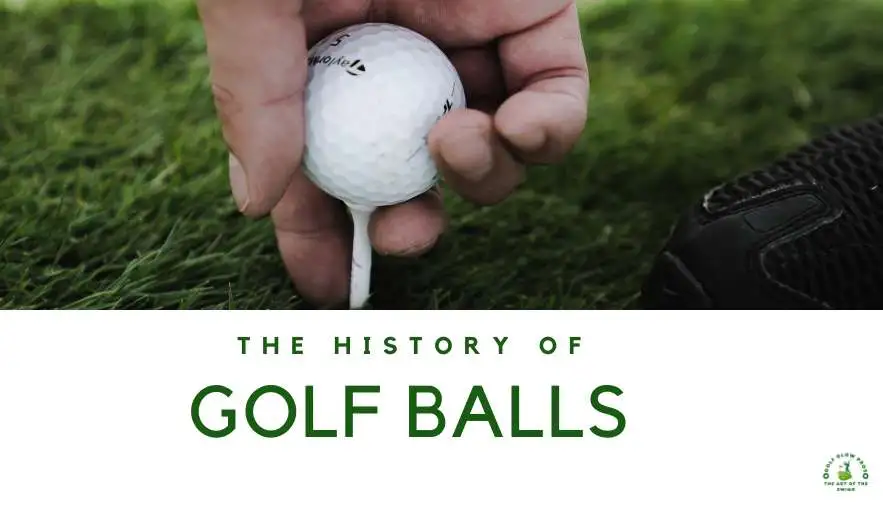Hi there, friends who love to play golf! Ever find yourself thinking, “How did we end up here, chasing a little white ball with sticks?” as you meander through the course and appreciate the abundance of verdant vegetation?
Amidst the lush surroundings, it’s hard not to reflect on how we found ourselves on this golf course, immersed in the joy of pursuing that elusive white ball. So let’s get started; learning about the history of golf is just as interesting as playing the game.
Let us imagine that we are going to take a look at the game’s origins and see how it all began. Picture Scotland, undulating hills, and shepherds with an excessive amount of leisure time. Yes, that is where golf got its start.
But wait, we’re not just discussing the game’s inception here. We’re getting technical: how did the earliest golfers come to the conclusion that hitting a ball into a hole in the ground and calling it a sport was a good idea?
The secret to winning, after all, was determined by someone to be hitting the ball with fewer blows. Who wrote those holy rules of the gods of golf? I promise you, it’s a story full of spirited arguments, dubious wardrobe decisions, and most likely a few clubs thrown.
But there’s still more! We’ll look at early gear and the modest origins of clubs, which may help you appreciate your high-tech drivers a little more. Wooden balls and spheres filled with feathers – it feels like you’re the curator of a golf museum.
In golf history books, there are many illustrious individuals whose names must not be overlooked.
The pioneers, such as Bobby Jones and Old Tom Morris, contributed significantly to shaping the modern game. Their tales resemble folklore surrounding golf, laced with a dash of drama, rivalry, and victory.
If you spend some time exploring these historical nooks and crannies, you might discover that you have a whole new perspective on your game.
Perhaps, by knowing a little about the history of this sport, you will be able to improve your swing or appreciate that difficult putt that much more.
Get ready to embark on a historical adventure, so don your metaphorical golf cap and dive in! When we’re through, you’ll be dying to get out on the course, not just with clubs in your hands but also with memories of golf’s past resonating in your head.
Prepare to be enthralled – the history of golf, my friends, is revolutionary. Let’s travel back in time! ⛳🏌️♂️
When and Where Was Golf Invented?
The documentation of various historical golf variations, some dating back to the first century B.C. in the Roman Empire, reveals an intriguing evolution of the sport.
However, many historians contend that the game’s modern incarnation began in Scotland during the fifteenth century.
Let’s begin our historical study of golf by choosing a spot. Where did golf get its start? While there is debate over some historical details, scholars generally agree that golf originated in Scotland in the fifteenth century.
There are a lot of fascinating turns and turns in the early history of golf. Initially, players used bent sticks to hit pebbles over or around sand dunes in the game. It gained popularity fast and even caught the Scottish government’s attention.
The parliament of King James II outlawed the game in the 1450s because young men were using it as an excuse to put off finishing their military training.
King James IV’s adoption of golf shortly after 1500 gave the sport official royal approval. As golf gained popularity in Europe during the 16th century, it began to take on the characteristics of modern golf by the 1700s.
In 1744, enthusiasts formulated the first “rules of golf,” and, in 1764, they constructed the first 18-hole course.
Is Golf the Oldest Sport in the World?
Although golf has a history that dates back to the 15th century in Scotland, it is not the oldest sport in the world. Still, it is among the oldest. Many prehistoric societies actively engaged in a variety of physical pursuits and games that fall into the category of sports.
For instance, ancient Greece, Rome, Egypt, and China were the birthplaces of civilizations that engaged in sports like swimming, running, archery, and wrestling.
The definition of a sport can differ, and there is frequently little evidence of ancient sports, making it difficult to determine which is the “oldest” sport. In addition, many sports have changed in form and regulations over time.
Although golf isn’t the oldest sport in absolute terms, it is undoubtedly one of the oldest, with a well-documented origin story.
The Origins of Modern Golf
In order to become what it is today, golf has undergone dramatic changes over the centuries. Throughout its evolution, golf has evolved from its early forms through the standardization of rules, the development of golf clubs and balls, and the organization of sanctioned competitions.
1. Golf’s Early Forms (15th Century)
By using sticks to hit balls toward targets, Scottish players developed golf’s origins during the fifteenth century.
2. The First Rules to Be Recorded (1744)
In 1744, the Company of Gentlemen Golfers at Leith, near Edinburgh, Scotland, recorded the first-ever golf rules. Forming the basis of the game, these regulations—published under the heading “Articles and Laws in Playing at Golf”—were extremely important.
3. Establishment of Golf Clubs
St Andrews was among the first golf clubs established in the 18th century. The 1754 founding of the Royal and Ancient Golf Club of St Andrews had a significant influence on the customs and regulations of golf.
4. Equipment Evolution
Over time, there have been major changes to golf equipment. The gutta-percha ball eventually took the place of the feather ball, which was first used in the 17th century and in the middle of the 19th century. The sap of the gutta-percha tree helped standardize play and made the new ball more durable.
5. Growth Outside of Scotland
The game of golf began spreading outside of Scotland during the 18th and 19th centuries and into England and the other British Isles.
6. The Open Championship
There is no doubt that Prestwick Golf Club in Scotland established the world’s first major golf tournament in 1860, marking a significant breakthrough in the history of competitive golf.
7. The evolution of professional golf
In the late 19th and early 20th centuries, a number of enthusiasts actively contributed to the professionalization of golf and the creation of professional tournaments.
8. The Masters Tournament’s debut in 1934
For the first time, the Masters Tournament was held at Augusta National Golf Club in 1934.
9. Modern Times and Globalization:
With the establishment of international tours and the increasing involvement of players from around the world, the global landscape of sports has become more interconnected and diverse.
Golf has evolved into a global sport in the latter half of the 20th and early 21st centuries.
10. Technological Progress:
Modern golf has continued to grow and become more popular due to developments in equipment technology, course design, and the professionalization of the game.
Where Does the Word ‘Golf’ Come From?
The word “golf” has a murky origin, and its etymology has been the topic of some discussion. While none of the theories can be proven beyond a reasonable doubt, the scientific community widely accepts some more than others.
1. Dutch and Scots Origins:
The widely accepted theory suggests that the word “golf” may have its origins in the Middle Dutch words “colf” or “kolf,” where “kolf” denoted “club,” and people played the game “colf” with a ball and an object resembling a club.
The Scots are thought to have borrowed the term “golf” from the Dutch as the game of golf moved from the Netherlands to Scotland. The change from “colf” to “golf” may have resulted from the Scottish custom of appending a “g” to words that start with “c.”
2. Old English and Scottish Terms
According to a different theory, the word “golf” may have come from the Old English and Scottish words “gouf” or “goff,” which denoted a particular type of mallet used in a number of medieval games.
Linguistic changes over time may have contributed to the evolution of “gouf” into “golf”.
3. Potential Impact of Gaelic:
In some studies, scholars have suggested a connection between golf and the Scottish Gaelic word “golf,” meaning “to strike” or “to cuff.”
Early Golf Equipment
Throughout history, golf equipment has undergone significant changes, evolving from rudimentary tools to sophisticated gear designed to enhance performance and cater to the evolving needs of players Since the game’s beginnings at the beginning of the 20th century.
Golf equipment has continually advanced, from basic clubs and balls to the sophisticated equipment that is used today.

Here’s a quick rundown of the original golf equipment:
1. Clubs:
Featherie Clubs:
When golf first gained popularity, players and regional artisans frequently made their own clubs. During the 17th and mid-19th centuries, players used clubs with wooden shafts and heads to hit featherie balls. With names like “play clubs” and “spoons,” these early clubs came in a wide range of designs.
Bulgers and Longnoses:
Club designs changed when the gutta-percha ball took the place of the featherie ball in the middle of the 1800s. Due to their long, thin shape, “longnose” clubs gained popularity. Subsequently, “bulger” clubs became popular, featuring a thicker, protruding back design.
2. Balls:
Featherie Ball:
Originally, featherie balls were wooden golf balls. In order to create the featherie, feathers were stuffed into a leather pouch and sewed shut. Compared to wooden balls, it offered greater control and range.
Gutta-Percha Ball:
In the middle of the 1800s, the gutta-percha ball was introduced. As a result, people shaped the gutta-percha tree’s rubbery sap into a circle. The game gained popularity because the gutta-percha ball was less expensive and more durable than the featherie.
3. Golf Bags:
Early players did not use the ornate golf bags that are used today. Rather, they frequently used a basic carrying pouch or held a few clubs in their hands. As the number of clubs and other accessories increased, golf bag designs had to change as well.
4. Clothes and Sneakers:
Early golfers usually dressed in formal attire, such as suits or other everyday clothes. Golf attire such as knickerbockers, button-up shirts, and caps developed as the sport grew in popularity and organization. For increased traction, shoes with nails or spikes were an option.
5. Accessories:
Traditionally, golfers used wooden tees, scorecards, and crude flags to mark holes. During the course of the game, these peripherals became increasingly standardized.
Technological developments, including the use of advanced materials, more complex club designs, and the introduction of steel shafts, further changed golf equipment as the game of golf grew and became more professional.
In order to play golf, golfers today use a variety of specialized clubs, cutting-edge balls, and other cutting-edge equipment.
The History of Golf Clubs
Though you undoubtedly adore this game, how much do you actually know about its history? Golf clubs have a fascinating history.
A quality set of golf clubs can make all the difference in the game. Every kind of golf club has a specific function in the game. The appearance of golf clubs and the game has changed significantly from its prehistoric beginnings.
The history of golf imparts valuable lessons about the game and the evolution of the clubs players use. The advancement and evolution of golf clubs have benefited both amateur and professional players.
1. Featherie Ball Era (17th to mid-19th century):
In the early years, skilled craftsmen handcrafted golf clubs, offering players a variety of designs. Players utilized different clubs, such as “play clubs” and “spoons,” each serving a distinct function.
During the featherie ball era, golfers used wooden clubs with long, thin shafts. The wood used to make these clubs was either hazel, ash, or hickory. Craftsmen carved heads from hardwood with various lofts and shapes.
2. Transition to the Gutta-Percha Ball (Mid-19th century):
Golf club designs started to shift with the introduction of the gutta-percha ball, which was more resilient than the featherie. The gutta-percha ball made it possible to create more uniform club designs.
3. Longnose and Bulger Clubs (Mid-19th century):
“Longnose” clubs gained popularity during the gutta-percha ball era. These clubs had a long, thin head and a slightly curved face. Golfers frequently carried a set of clubs with varying lofts for different shots.
Later in the 19th century, “bulger” clubs—characterized by a thicker and protruding back design—began to appear. With more weight behind the ball, these clubs increased accuracy and distance.
4. Hickory Shaft Era (Late 19th to Early 20th century):
One important change that occurred in the late 19th century was the switch to hickory shafts. Hickory provided stability, strength, and adaptability. During this time, craftsmen actively crafted clubheads from wood, often designing them in a pear-shaped manner.
5. Steel Shaft Innovation (Early to Mid-20th century):
In the early 20th century, manufacturers introduced steel shafts, marking a significant technological advance. Steel, compared to hickory, provides more consistency and durability, facilitating the creation of a greater range of clubhead designs.
6. Modern Era (Mid-20th century to Present):
By the middle of the 20th century, designers and engineers actively embraced new developments, introducing club heads made of persimmon wood and creating irons with cavity backs to enhance forgiveness.
The use of composite materials for clubheads, such as titanium and graphite, has changed during the past few decades. As a result of technological advancements, many golf clubs are now equipped with a wide range of standard features and perimeter weighting.
7. Specialization of Clubs:
Modern golfers use a set of clubs with distinct functions. These include drivers for distance, irons for approach shots, wedges for accuracy in the short game, and putters for accuracy on the green. Every kind of club has a distinct layout and set of rules.
Golf’s continuous drive for innovation and improvement actively shapes the history of golf clubs. Golfers now actively choose from a broad selection of clubs, tailoring them to match their unique playing preferences and styles.
The History of Golf Balls
Over its lengthy existence, the standard golf ball has experienced numerous improvements and modifications. The golf ball has had nearly 600 years to evolve since the game of golf was first played in Scotland in the early 1400s.
The evolution of the golf ball illustrates significant changes in the game’s lengthy history as well as significant golf landmarks. The evolution of the golf ball itself had an impact on the rules of the game, the golf course, and the golf club.

Technology and tradition have long been in conflict, a topic of discussion as old as golf itself. It’s even possible to argue that, in the context of golf, traditions from the past are now part of the present.
Approximately 25,000 golf courses host 900 million rounds of play annually for 50 million golfers worldwide. It is obvious that golf has grown immensely in popularity, and the resulting industry is very profitable.
1. Wooden Balls:
In the past history of golf, craftsmen hand-carved golf balls out of boxwood or beech, using wood for the manufacturing process. They were in use in Scotland and other parts of Europe during the early years of the game.
2. Featherie Balls (14th to 17th Century):
The invention of the featherie ball in the fourteenth century represented a major breakthrough in the history of golf ball technology.
In this process, individuals typically stuffed feathers, often from chickens or geese, into a leather pouch to create the object. Subsequently, they sewed the leather shut to form a circle. The featherie performed better and was more resilient than wooden balls.
3. Gutta-Percha Balls (Mid-19th Century):
During the middle of the 1800s, the gutta-percha ball had a revolutionary effect. The gutta-percha tree, which grows throughout Southeast Asia, produces sap used in making gutta-percha—a material resembling rubber.
Manufacturers shaped these balls like a ball and found them to be less expensive and more robust than featheries. Because of their smoother surface, gutta-percha balls played more consistently.
4. Haskell Ball (1898):
In 1898, American Coburn Haskell achieved a significant advancement by creating the Haskell ball. It had a rubber core wrapped in rubber threads and covered. This design, known as the rubber-winding process, significantly increased the ball’s durability, performance, and distance.
5. Evolution of Cover Materials (Early 20th Century):
More innovation in golf ball covers came about as the 20th century went on. Natural rubber called balata gained popularity as a golf ball cover material because of its responsiveness and softness. Balls covered in balata provided more spin and control when playing near the greens.
6. Two-Piece Golf Balls (1960s):
The introduction of the two-piece golf ball in the 1960s revolutionized the golf industry. These balls had a synthetic cover, usually Surlyn, and a solid rubber core. Two-piece balls offer greater distance, durability, and consistency.
7. Multi-Layer Balls (1990s Onward):
Multi-layer golf balls first appeared in the 1990s. Skilled craftsmen intricately constructed these balls, designing several layers, each serving a distinct function. They usually consisted of a cover, one or more mantle layers, and a solid or liquid core. The design sought to maximize spin, control, and distance.
8. Urethane Cover Balls (Late 20th Century):
Urethane-covered golf balls became more and more popular because of their superior feel and control. Professional golfers frequently use urethane-covered balls because of their propensity to produce spin-on approach shots.
9. Advancements in Dimple Patterns and Aerodynamics:
Golf balls’ lift and drag properties have improved as a result of ongoing research in aerodynamics and dimple patterns. Manufacturers are always improving these features to increase control and distance.
10. High-Performance Balls (21st Century):
In the twenty-first century, golfers have access to a wide range of high-performance balls made using cutting-edge materials and construction techniques.
Catering to players with different skill levels and preferences involves tailoring compression levels, cover materials, and dimple designs.
The development of new technologies and materials to enhance the performance and playability of golf balls throughout history is exemplified by the constant pursuit of innovation in the golf ball industry.
Golfers can now choose from a broad range of balls tailored to their unique playing requirements and styles.
The History of Golf Tees
The golf tee has a long history that began in the 1500s. For about 300 years, people would wet the sand with a towel and pile dirt to raise the ball slightly off the ground.
In the 1744 original golf rules, golfers had to “tee” their balls from the ground. Golfers could tee up their balls using objects from the ground as long as they were within one club length of the original hole.
Old Tom Morris redesigned the course, and St. Andrews became the first to divide teeing grounds from putting areas as the game grew over time.
1. Early Tees (17th to 19th Century):
Golfers used to play the game with the ball right out of the ground, usually on sand or soil. As “teeing grounds,” players would construct little sand mounds to raise the ball a little bit.
2. Turfing Pegs and Sand Tees:
To tee up the ball, golfers first used wooden or tiny turfing pegs embedded in the ground. Golfers, often on the spot, made these early tees themselves, and they were simple.
3. Development of the First Commercial Tee (19th Century):
George F. Grant received a patent for the first commercial golf tee in 1899. African-American dentist Grant patented a t-shirt with a rubberized top. The rubber top made the golf ball’s surface more forgiving and assisted in lowering resistance during the swing.
4. Evolution of Tee Designs:
The tee design developed further as golf became more and more popular. Wooden tees that held the ball in a tiny cup became popular. Golfers could now tee up the ball quickly and consistently, reducing the time and effort required to construct a temporary tee.
5. Transition to Plastic Tees (20th Century):
Plastic t-shirts gained popularity in the middle of the 20th century. These t-shirts were affordable, long-lasting, and of a constant height. The plastic tee’s design held the ball firmly with a narrow shaft and a wider cup.
6. Adjustable and Specialty Tees (Late 20th Century Onward):
With the invention of adjustable tees in the latter half of the 20th century, golfers could now adjust the tee’s height to match their preferred playing style and club. Additionally, we made specialty tees available in a range of styles and materials.
7. Biodegradable and Eco-Friendly Tees (21st Century):
Golf tee manufacturers have responded to growing environmental consciousness by offering eco-friendly and biodegradable tee options. The natural degradation of these tees over time reduces the environmental impact of golf equipment.
8. Performance Tees:
In order to accommodate varied playing conditions and player preferences, modern golf tees are available in a variety of materials, lengths, and designs. “Some tees aim to increase ball speed and reduce friction, while others prioritize durability.”
Golfers now have access to a large selection of tee options, such as plastic tees, specialty tees made to improve performance, and classic wooden tees. Since they give players a reliable and practical way to begin every hole, tees have become an essential component of the game.
The History of Golf Bags
The history of golf is extensive and illustrious, having its roots in Scotland several centuries ago. The equipment used by players changed as the game did, and a golfer’s golf bag is an essential piece of gear.
The golf bag has experienced an amazing metamorphosis over time, accommodating players’ evolving demands and tastes as the game’s appeal spread across the globe. Golfers used to carry just a few clubs when they played on Scotland’s windswept links in the early days of the sport.
These simple golf bags were more utilitarian than stylish; Golfers typically crafted these carriers from straightforward materials, intending them solely for carrying a small number of clubs around the course.

The demand for increasingly advanced and practical equipment increased as golf moved outside of Scotland and became more popular elsewhere in the world. Golf bags became increasingly specialized and well-organized as a result of golfers using caddies to carry their clubs.
Golf enthusiasts actively designed early golf bags, considering factors such as club organization, carrying convenience, and club protection.
With the growth of professional golf and the introduction of televised competitions in the middle of the 20th century, golfers became iconic personalities, and their gear came to the forefront of public attention.
This increased attention to the sport spurred innovations in golf bag design and materials. Manufacturers started experimenting with various textiles, introducing strong, lightweight materials that improved the bags’ functionality while also adding a fashionable touch.
The range of golf bags that players could choose from increased dramatically in the last decades of the 20th century. Golfers could conveniently prop their stand bags on the course thanks to their built-in legs, which also helped to preserve the bag and clubs.
Golf cart bags have specific pockets and quick access to clubs for a convenient golfing experience. Manufacturers designed these for use on golf carts.
In recent years, the incorporation of technology into the game has actively influenced the design of golf bags. The bag manufacturers have responded to the modern golfer’s demand for convenience and performance by incorporating built-in phone chargers, GPS devices, and Bluetooth connectivity into some bags.
The history of golf bags chronicles the development of a sport that has endured over time. From its humble origins on Scottish links to the sleek, high-tech bags now seen on courses, the golf bag has actively served as both a functional and symbolic representation of the game’s adaptation to modern times.
Studying the evolution of golf bags reveals more about how the game has progressed and the enduring appeal of a sport that continues to attract players and enthusiasts from all over the world.
1. Early Days:
Golfers did not carry specialized golf bags in the early days of the game. Rather, they used caddies to help them or held their clubs in their hands. Golfers frequently had a small collection of clubs, so having a special bag was not as important.
2. Introduction of Golf Bags (Late 19th Century):
Golfers realized they needed a useful way to carry their clubs when the game gained popularity in the late 19th century. Craftsmen fashioned the original golf bags from simple materials such as canvas or leather.
They frequently had the appearance of sizable duffel bags with an over-the-shoulder strap.
3. Evolution of Design:
Golfers can now more easily organize and access their clubs during a round thanks to the evolution of golf bag design, which now includes sleeves or compartments for individual clubs. The bags included pockets for balls, tees, and other accessories.
4. Introduction of the Stand Bag (Early 20th Century):
The stand bag was first introduced in the early 1900s. Retractable legs on this invention allowed the bag to stand straight on the course. Golfers can now easily access their clubs while playing, eliminating the need to lay their bags on the ground.
5. Lightweight Materials (Mid-20th Century):
As materials technology developed, manufacturers actively incorporated lightweight materials like nylon and other synthetic fabrics into golf bags. Golfers found it easier to carry their bags for the full 18 holes as a result.
6. Cart Bags and Carry Bags (Later 20th Century):
Cart bags made especially for use on golf carts gained popularity along with the vehicles. These bags were frequently larger than standard carry-alls and featured a more structured design.
Carry bags have developed further, catering to the needs of walkers.
7. Introduction of the Cart and Stand Hybrid Bag (Late 20th Century):
Manufacturers designed certain golf bags to function as stand-alone bags or cart bags. Depending on their preference, golfers could choose to carry their clubs or use a cart, thanks to these hybrid bags.
8. Specialized Pockets and Features (21st Century):
Golf bags have evolved into more specialized items in the twenty-first century, featuring insulated drink compartments, rangefinders, and numerous pockets for valuables. Certain bags come equipped with built-in GPS systems or the ability to charge electronic devices.
9. Innovations in Materials and Design:
In order to improve longevity, usability, and aesthetics, golf bag manufacturers are constantly experimenting with new materials and designs.
Premium golf bags now consider ergonomic strap systems, water-resistant zippers, and full-length dividers as standard features.
Golfers can select a bag based on their preferences, style of play, and favorite types of courses. The evolution of golf bags over time is indicative of the continuous endeavors to enhance players’ convenience and enjoyment of the game.
The History of Golf Clothing
With so many various golf-related items and services, including clubs, courses, and caddies, it is all too easy to forget about an important part of the sport: attire.
Although sponsorship undoubtedly has a significant influence on the modern game, golf apparel as a whole has grown to be associated with the sport over time.
Come along as we unveil everything, highlighting some of the most significant developments in golf fashion along the way.
1. Early Attire (15th to 18th Century):
When golf first began in Scotland in the fifteenth century, players’ outfits reflected the general fashion of the day. Golf was first developed as a laid-back pastime, and players most likely played in clothes they would normally wear on a daily basis.
- Fabrics and Styles:
It was common for people to make clothing from wool, linen, and cotton in the 15th and 18th centuries.
As a general rule, people wore fitted pants, hats, and long-sleeved shirts to protect themselves from the weather and provide a degree of durability.
- Layering:
Layering was a common fashion choice in Scotland due to the frequently unpredictable weather. In order to stay warm in the chilly weather, golfers would probably dress in multiple layers. This is an example of wearing a tunic or long-sleeved shirt over a lighter shirt.
- Headwear:
During this time, caps or hats were an essential part of golf apparel. In addition to offering sun protection, these head coverings had a practical function by keeping hair out of the face while swinging.
- Footwear:
Strong leather boots or shoes would have been the norm for footwear.
Early golfers played on natural terrain, so these shoes provided stability and traction.
- Absence of Formal Dress Codes:
There were no official dress codes or predetermined expectations for attire in the early days of golf. The distinction between golf attire and regular wear didn’t exist because people played the game for fun and relaxation.
- Evolution Over the Centuries:
The history of golf evolved from a casual pastime to a more structured and formalized sport as it went on, particularly in the 18th century. The fashion shifts were accompanied by the emergence of golf-specific apparel, and over time, some courses eventually implemented more formal dress codes.
It’s significant to remember that early golfers wore clothing that was appropriate for the weather and practical for the game. Because modern golf apparel had not yet made an appearance, the focus was on comfort and practicality rather than style or complexity.
When golf became more popular, golf clubs and courses started to set their own dress codes, which prompted the shift to more specialized golf apparel.
2. Introduction of Knickerbockers (Late 19th Century):
With the invention of knickerbockers in the late 1800s, golf apparel underwent a significant change. During this time, the unique knee-length pants known as “knickers” or “plus-fours” emerged as a key component of golf fashion.
- Emergence of Knickerbockers:
Originally, knickerbockers were a type of breeches from Europe that ended just below the knee. Because of their utility on the golf course, golfers embraced this style, which saw particular popularity in England and Scotland.
- Functional Design:
The design of knickerbockers for golfers practically met the need for mobility. The knee-length cut alleviated some of the limitations that longer pants might have caused by allowing for greater mobility during the golf swing. Usually fitting loosely around the thighs and hips, the pants narrowed to a buckle or cuff just below the knee.
- Golfing Attire Becomes More Specialized:
The introduction of knickerbockers signaled a break from the more commonplace daily wear of golf’s early years. Golfers started wearing apparel designed specifically for the demands of the game.
- Material and Styling:
Designers frequently crafted knickerbockers from traditional materials like wool or tweed, reflecting the era’s fashion sensibilities, and they often paired them with knee-high socks to meet the practical needs of the golfer while maintaining a formal appearance.
- Evolution of Women’s Golf Attire:
Women’s golf wear began to follow suit as golf became more and more popular with women. Divided or knee-length skirts, replacing the long skirts that had dominated Victorian fashion, became the choice of women opting for practicality and comfort.
- Influence on Fashion:
The introduction of knickerbockers to the game of golf had an impact on the course. Around the end of the 19th and the beginning of the 20th centuries, this particular look started to move beyond sports and became popular in both casual and formal clothing for men and women.
- Shift in Dress Codes:
The acceptance of knickerbockers on the golf course was indicative of a larger change in societal perceptions regarding clothing codes.
A shift from the strict formality of Victorian fashion occurred in the late 19th century, and knickerbockers symbolized a more carefree and utilitarian attitude to dressing.
A major turning point in the development history of golf apparel was the introduction of knickerbockers. This design not only met the practical needs of golfers, but it also helped create a unique golfing aesthetic that would grow over the ensuing decades.
The enduring appeal of vintage golf attire and the nostalgia associated with classic golf fashion testify to the influence of knickerbockers.
3. Shirts and Ties (Early 20th Century):
Golfers frequently wore jackets, ties, and long-sleeved shirts when they played in the early 20th century. This formal clothing matched the era’s general fashion trends. But as the game became more widely available, there was a change toward more relaxed and casual dress.
4. Era of Golfing Icons (Mid-20th Century):
The styles of golfing icons such as Arnold Palmer and Gary Player greatly influenced golf fashion during the middle of the 20th century.
Typical golf clothing items included sweaters, slacks, and collared shirts. Additionally, women’s golf apparel adopted a more fitted and elegant style.
5. Casualization of Golf Attire (Late 20th Century):
Golf apparel became more casual in the latter half of the 20th century. It has become more common for golfers to wear jeans, khaki shorts, and short-sleeved polo shirts on some courses as opposed to the more formal dress codes of the past.
6. Sporty and Technical Fabrics (Late 20th Century Onward):
Sporty and technical textiles have been incorporated into golf apparel as a result of advancements in textile technology. Stretchy blends, breathable fabrics, and moisture-wicking materials have become common features of golf shirts, pants, and outerwear. In order to improve on-course comfort and performance, these innovations were developed.
7. Rise of Golf Brands and Logos (Late 20th Century Onward):
Golf brands began to have a significant impact on golf fashion. On golf apparel, logos and branding have become commonplace, with players frequently endorsing particular clothing lines.
8. Contemporary Golf Fashion (21st Century):
Golf fashion has expanded in diversity in the twenty-first century, offering a variety of brands and styles to suit a wide range of preferences. Transitioning into the modern era, traditional looks have seamlessly integrated with contemporary athletic styles. Moreover, golfers now have the option to embrace streetwear with golf-inspired designs, further enhancing the breadth of choices available in the world of golf fashion.
9. Inclusivity and Diversity:
Golf fashion has become more inclusive as a result of the golf industry’s efforts to promote diversity and inclusivity. It’s acknowledged that golf apparel can be traditional or modern to suit a variety of personal preferences.
Golf apparel nowadays is an amalgam of history, innovation, and individuality. Golfers are free to dress in a way that not only satisfies the rules of the course but also expresses their personal sense of fashion and comfort. The evolution of golf apparel over time reflects broader societal shifts and fashion trends.
Is Golf an Expensive Sport to Play?
It’s true that golf can be somewhat expensive, but your approach is ultimately what matters. We can say golf is the most expensive play in the world. You need to purchase clubs, shoes, balls, carts, and bags before even reaching the course and paying your green fees.
There are always ways to participate for less money, such as playing during off-peak hours, driving more frequently, or using an old or used set of clubs. Allow me to explain it to you:
1. Course Fees:
Alright, so there’s a lot of variation here. Certain courses are very expensive, especially during busy hours. They are very fancy. However, there are lots of free classes available that won’t break the bank. It’s all about determining the ideal location.
2. Equipment Costs:
Golf clubs can be rather expensive. You have everything you need, including your putters, drivers, and irons. However, here’s the thing: You don’t need the best products available when you first start out. Reasonably priced options that will fulfill the task are available.
3. Apparel and Accessories:
You may have seen professionals dressed to the nines, but you don’t have to follow suit. Respectable-looking, reasonably-priced golf outfits that won’t make you gag at the register are available.
4. Membership Fees:
There’s no denying that private club dues can be high. However, there are lots of affordable membership-only public and semi-private courses available. Even though there won’t be a luxurious locker room, you will still be able to play golf.
5. Lesson Costs:
Taking lessons from a pro to improve your swing can get expensive. In addition, there are clinics and group classes that won’t empty your wallet as fast.
6. Travel Expenses:
If you’re a golfer who travels frequently, your travel expenses may add up. However, most of us won’t go broke playing at the nearby course. Save the elaborate golf outings for your ideal getaway.
7. Maintenance and Upkeep:
Golf courses require mowing, and clubs require occasional attention. Although it all adds up, you can control these expenses. Consider volunteering for a course cleanup day or learning how to regrip your clubs.
Indeed, golf can be costly if you play exclusively with high-end equipment, but there are many other ways to have fun without breaking the bank. It all comes down to identifying the ideal balance between affordable and high-quality options.
Having fun on the course is ultimately more important than how much it costs to get there!
History of The Masters Golf Tournament
If you ask most professional golfers in America which major they would most like to win, they’ll probably say the Masters. The storied and prestigious Augusta National Golf Club hosts The Masters Tournament, the highest competition in golf, every year during the first full week of April.
The Masters have the distinction of being “a tradition unlike any other” due to a combination of circumstances. The golf course is the first, naturally. For many golf enthusiasts, Augusta National’s verdant appearance on TV marks the official arrival of spring.
Fans learn the layout of the course and develop empathy for the challenges portrayed on TV as they follow the players as they attempt to master Augusta’s perplexing elevation changes and treacherous greens. With each tournament, the ever-expanding mystique surrounding the grounds deepens, adding yet another layer of memories, collapses, and triumphs.
Aside from the course, what makes the competition special is that it provides both a once-in-a-lifetime chance for some of the sport’s lesser-known athletes and, at the same time, a demanding test for the best players in the world.
The field extends invitations to the top 50 players in the OWGR, recent major winners (as well as the top four finishers from the previous year), and every player who won a PGA Tour event in the previous year.
Nonetheless, it also extends invitations to the victors of some of the most prominent amateur competitions worldwide as a tribute to the tournament’s origins and creator, Bobby Jones.
Of the four majors in the sport, the Masters is the newest. However, it has the most interesting history in many respects. One of the best golfers in America had a seed of an idea that grew into one of the biggest competitions in the world.
Alright, golf enthusiasts, assemble! We will delve into the fascinating past of the Masters Tournament, the esteemed competition that elevates April to a somewhat exceptional status in the golf world.
1. The Augusta National Dream (1931):
Bobby Jones, the renowned amateur golfer, shares his dream. Together, he and Clifford Roberts decided to construct Augusta National Golf Club, their ideal golf course.
Indeed, in 1931, a significant event occurred.
2. First Green Jacket (1934):
Let’s jump ahead to the first Masters Tournament, which took place in 1934. The guy with the swing, Horton Smith, leaves with the first-ever green jacket. The custom of the winner wearing a green jacket wasn’t started until a few years later; however, we’ll discuss that in a moment.
3. The Trademark Green Jacket (1949):
Alright, let’s go back to that famous green jacket that Sam Snead wore in 1949. “And that’s when it becomes a master custom, moreover, for the victor to look amazing in green.” It resembles the cutest club membership coat you’ve ever seen.
4. The Augusta National Par 3 Course (1958):
This course was first opened for play in 1958. During Masters week, it hosts a fun Par 3 Contest, so, it’s not just for show. Before the main event, there’s a little friendly competition, you know? Additionally, the Par 3 Contest adds an enjoyable and lighthearted dimension to the proceedings, creating a festive atmosphere leading up to the main tournament.
5. The Tiger Woods Era (1997):
“Tiger Woods is a household name when discussing the Masters; his legendary performances and multiple victories have cemented his status as a golf icon.”
Tiger created tournament history in 1997 by winning by an incredible 12 strokes. He seemed to be playing a distinct game outside.
6. The Legendary Amen Corner:
The fabled Amen Corner is located along the lines of holes 11, 12, and 13. This word gained fame thanks to the Masters. Drama and beauty are inextricably linked to Augusta National’s creation and destruction of dreams.
7. Jack Nicklaus’ Final Victory (1986):
Imagine this: in 1986, Jack Nicklaus became the oldest winner of the Masters at the age of 46. It’s similar to a screenplay from Hollywood. One last time, as the Golden Bear demonstrates how to do it, the young guns eagerly witness the demonstration.
8. The Dramatic Chip-In (2005):
Tiger Woods’ incredible chip-in on the sixteenth hole in 2005 shows. Before finally succumbing to gravity, the ball appears to linger on the cup’s edge for an eternity. Anybody got goosebumps?
9. Augusta National’s Signature Blooms:
When discussing the Masters, it is essential to highlight the azaleas and dogwoods. The course enhances the tournament’s charm, a floral masterpiece in April.
10. Tradition Unlike Any Other:
Accurate in its portrayal, the tradition unlike any other is often referred to as “a tradition unlike any other.” Beyond just being a competition, the Masters is a masterpiece history of golf, including everything from the green jacket ceremony to the famous azaleas.
That concludes our brief tour through the well-kept fairways of Masters history.
It’s more than just a golf competition; it’s an amalgam of magic, tradition, and spectacle. I wholeheartedly agree!
So there you have it – the incredible and crazy journey through the history of golf! Starting with the well-groomed greens of Augusta National, golf has seen it all, from the shepherd’s romp through Scotland.
As I have explored the history of golf, I have discussed the use of wooden clubs, feather-filled balls, and the beginnings of such renowned competitions as the Masters.
The history of golf has evolved into a timeless activity thanks to the advancement of clothing, gear, and the intrinsic nature of the game.
Consequently, bear in mind that the next time you tee up, you are contributing to a centuries-old legacy. Cheers to the fairways, the greens, and the excitement of pursuing that tiny white ball through the ages! Golfers, let’s swing! ⛳🏌️♂️












